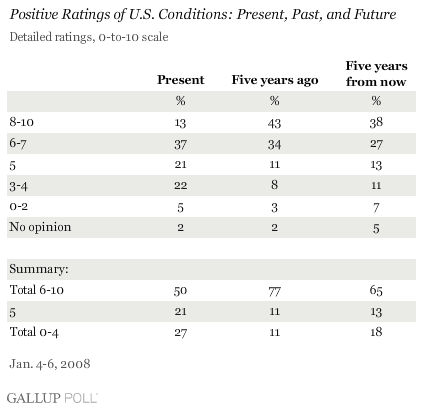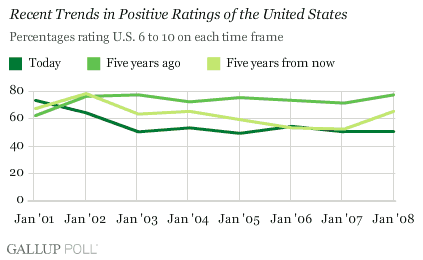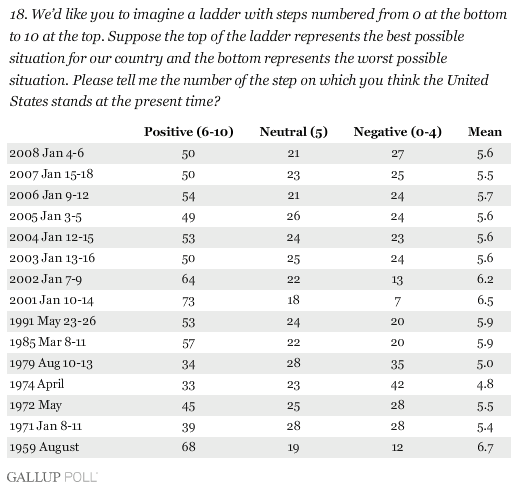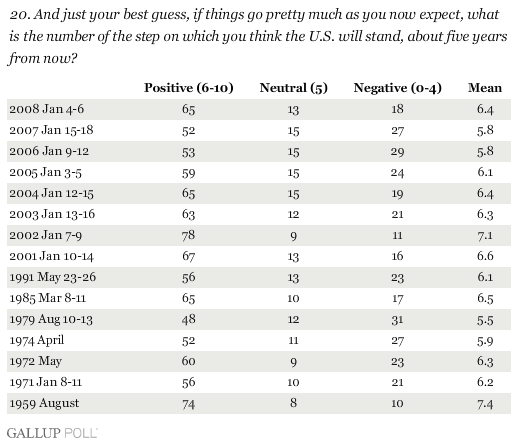PRINCETON, NJ -- Gallup's annual Mood of the Nation survey, conducted Jan. 4-6, 2008, finds a striking increase since January 2007 in Americans' belief that the country will be better off five years from now than it is today. Americans are typically upbeat on this measure, but today's level of optimism is the highest in four years.
The finding comes from a set of three questions that ask respondents to use an 11-point scale -- from 0 to 10 -- to indicate 1) where they think the nation stands at the present time, 2) where it stood five years ago, and 3) where it will stand five years from now.
Nearly-two thirds of Americans (65%) today predict that conditions in the country five years from now will be on the positive end of the scale (from 6 to 10). That's up from 52% last January. Perceptions about where the country stood five years ago have improved slightly (from 71% to 77%) and, as a result, Americans remain more positive about the past than they do about the future. At the same time, there has been no change in perceptions about where the country stands at present. Half of Americans give present conditions a positive rating.

Detailed 2008 results for each question accompany the story.

These findings stand in contrast to much more negative attitudes about the country found in recent Gallup polling. For instance, the January Mood poll finds only 24% of Americans saying they are "satisfied" with the way things are going in the country today, and 73% dissatisfied. Also, according to Gallup's latest economic polling (see "Consumer Confidence Takes a Tumble in Mid-January" in Related Items), the percentage of Americans rating economic conditions as either "excellent" or "good" is a dismal 24%, and only 12% of consumers think the economy is getting better.
Americans appear to be willing to express attitudes that are more positive about national conditions on the 11-point scale, in which finer gradations of positive and negative views can be conveyed.
Gallup has asked this "striving scale" set of questions each January since 2001. The 2001 poll turns out to have been the recent high point for public contentment with national conditions (73%). The percentage rating current conditions anywhere from 6 to 10 fell to 64% in 2002 and to 50% in 2003. (Older Gallup trends show much lower percentages of Americans giving the country positive ratings on the 0-to-10 scale at several points in the 1970s, including the lowest point of 33% in April 1974.)
While positive perceptions of current national conditions have remained flat at about the 50% level since 2003, Americans' forecast for where the country would be "five years from now" continued to decline, from 78% in 2002 to 53% in 2006. It held about steady in 2007 (at 52%) before increasing this year to 65%.

The recent boost in optimism about the future is seen about equally among Republicans and Democrats, suggesting it is not explained simply by Democrats looking forward to a new administration in Washington.

Whether Americans perceive that changes for the better are on the horizon, or believe current conditions are so bad they can only improve, isn't clear.
Survey Methods
Results are based on telephone interviews with 1,023 national adults, aged 18 and older, conducted Jan. 4-6, 2008. For results based on the total sample of national adults, one can say with 95% confidence that the maximum margin of sampling error is ±3 percentage points.
For results based on the sample of 423 Republicans or Republican leaners, the maximum margin of sampling error is ±5 percentage points.
For results based on the sample of 499 Democrats or Democratic leaners, the maximum margin of sampling error is ±5 percentage points.
For results based on the sample of 2,053 national adults, aged 18 and older, conducted Jan. 19-20, 2008, the maximum margin of sampling error is ±2 percentage points.
In addition to sampling error, question wording and practical difficulties in conducting surveys can introduce error or bias into the findings of public opinion polls.



